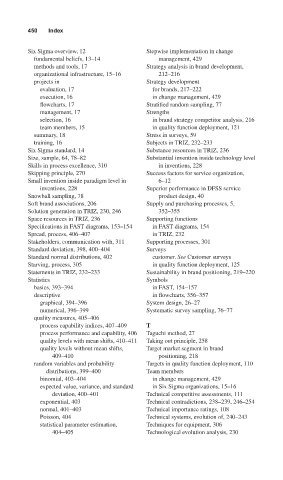Page 492 - Design for Six Sigma for Service (Six SIGMA Operational Methods)
P. 492
450 Index
Six Sigma overview, 12 Stepwise implementation in change
fundamental beliefs, 13–14 management, 429
methods and tools, 17 Strategy analysis in brand development,
organizational infrastructure, 15–16 212–216
projects in Strategy development
evaluation, 17 for brands, 217–222
execution, 16 in change management, 429
flowcharts, 17 Stratified random sampling, 77
management, 17 Strengths
selection, 16 in brand strategy competitor analysis, 216
team members, 15 in quality function deployment, 121
summary, 18 Stress in surveys, 59
training, 16 Subjects in TRIZ, 232–233
Six Sigma standard, 14 Substance resources in TRIZ, 236
Size, sample, 64, 78–82 Substantial invention inside technology level
Skills in process excellence, 310 in inventions, 228
Skipping principle, 270 Success factors for service organization,
Small invention inside paradigm level in 6–12
inventions, 228 Superior performance in DFSS service
Snowball sampling, 78 product design, 40
Soft brand associations, 206 Supply and purchasing processes, 5,
Solution generation in TRIZ, 230, 246 352–355
Space resources in TRIZ, 236 Supporting functions
Specifications in FAST diagrams, 153–154 in FAST diagrams, 154
Spread, process, 406–407 in TRIZ, 232
Stakeholders, communication with, 311 Supporting processes, 301
Standard deviation, 398, 400–404 Surveys
Standard normal distributions, 402 customer. See Customer surveys
Starving, process, 305 in quality function deployment, 125
Statements in TRIZ, 232–233 Sustainability in brand positioning, 219–220
Statistics Symbols
basics, 393–394 in FAST, 154–157
descriptive in flowcharts, 356–357
graphical, 394–396 System design, 26–27
numerical, 396–399 Systematic survey sampling, 76–77
quality measures, 405–406
process capability indices, 407–409 T
process performance and capability, 406 Taguchi method, 27
quality levels with mean shifts, 410–411 Taking out principle, 258
quality levels without mean shifts, Target market segment in brand
409–410 positioning, 218
random variables and probability Targets in quality function deployment, 110
distributions, 399–400 Team members
binomial, 403–404 in change management, 429
expected value, variance, and standard in Six Sigma organizations, 15–16
deviation, 400–401 Technical competitive assessments, 111
exponential, 403 Technical contradictions, 238–239, 246–254
normal, 401–403 Technical importance ratings, 108
Poisson, 404 Technical systems, evolution of, 240–243
statistical parameter estimation, Techniques for equipment, 306
404–405 Technological evolution analysis, 230

